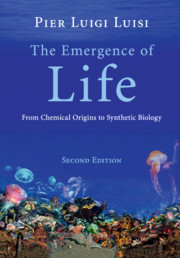Book contents
- Frontmatter
- Contents
- Acknowledgments
- Introduction
- Part I Approaches to the origin of life
- 1 Setting the stage
- 2 The hardware
- 3 Ascending the ramp of complexity
- 4 Experimental approaches to the origin of life
- 5 Origin of life from ground zero
- Part II What is life? The bio-logics of cellular life
- Part III Order and organization in biological systems
- Part IV The world of vesicles
- Part V Towards the synthetic biology of minimal cells
- As a way of conclusion
- Appendix The open questions about the origin of life
- References
- Names index
- Subject index
5 - Origin of life from ground zero
from Part I - Approaches to the origin of life
Published online by Cambridge University Press: 05 September 2016
- Frontmatter
- Contents
- Acknowledgments
- Introduction
- Part I Approaches to the origin of life
- 1 Setting the stage
- 2 The hardware
- 3 Ascending the ramp of complexity
- 4 Experimental approaches to the origin of life
- 5 Origin of life from ground zero
- Part II What is life? The bio-logics of cellular life
- Part III Order and organization in biological systems
- Part IV The world of vesicles
- Part V Towards the synthetic biology of minimal cells
- As a way of conclusion
- Appendix The open questions about the origin of life
- References
- Names index
- Subject index
Summary
Introduction
We have seen in the previous chapter the most common approaches to the origin of life, and despite the conceptual and operational differences, there is something in common which is quite interesting: they do not solve or even tackle the biogenesis of the basic macromolecular components, like DNA, RNA, and proteins. Several of these approaches start programmatically from a scenario in which the ordered sequences are supposed to be already extant. As said in a common metaphor, this is likened to building a house and starting with the roof.
It is necessary to work on the foundation. One may recall in this regard the work of old master Ponnamperuma, who in a 1976 review (Hulsof and Ponnamperuma) makes the point that all biopolymers are formally made out of the condensation of the corresponding monomers. Those reactions, that are unfavorable in aqueous solution, can proceed in the presence of condensing agents. Moreover, the authors made a series of important observations, for example that one of the most efficient condensing agent is polyphosphate.
This chapter will focus on the biogenesis of the primordial macromolecular components based on the prebiotic compounds at “our” disposal 4 Gya – a scenario I like to call the “ground zero approach.” This will include not only general approaches, but also single experiments, which have the characteristic of guiding us towards the biogenesis of proteins or nucleic acids as ordered structures. In a way, this is a continuation of the previous chapter, which was devoted to the hypotheses on the origin of life, and actually we have to deal with some slight repetitions. These are partly unavoidable, and they are partly called to reify certain points that I consider very important.
Prebiotic amino acids and peptides
What do we have at ground zero? We have considered this question already, but let us focus now on amino acids and peptides.
There is consensus on 10 prebiotic amino acids, namely the α-amino acids that are spontaneously formed under the Stanley Miller conditions, or similar ones. They are: Ala, Gly, Asp, Val, Leu, Glu, Ser, Ile, Pro, and Thr. Notice that in the 10 primordial amino acids, there are no aromatic ones.
- Type
- Chapter
- Information
- The Emergence of LifeFrom Chemical Origins to Synthetic Biology, pp. 97 - 116Publisher: Cambridge University PressPrint publication year: 2016



